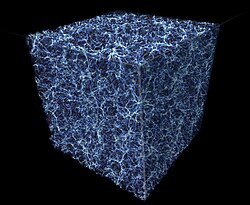Void (astronomy)
In astronomy, voids are the empty spaces between filaments. Filaments and voids are the largest-scale structures in the Universe. There are no or few galaxies in voids. Most voids have a diameter of 11 to 150 Mpc. Especially large voids are the empty spaces without many superclusters. These voids are sometimes called supervoids.
A 1994 official counting lists a total of 27 supervoids with a distance of up to 740 Mpc.[1]
| # | Name | Distance (Mpc) | Diameter (Mpc) |
|---|---|---|---|
| 1 | 188 | 124 | |
| 5 | 182 | 130 | |
| 9 | Southern Local Supervoid | 135 | 158 |
| 18 | 168 | 144 | |
| 19 | 168 | 152 | |
| 20 | Bootes Void | 304 | 110 |
| 21 | 201 | 163 | |
| 24 | Northern Local Supervoid | 86 | 146 |
Void (astronomy) Media
Matter distribution in a cubic section of the universe. The blue fiber structures represent the matter (primarily dark matter) and the empty regions in between represent the cosmic voids.
A 43×43×43-megaparsec cube shows the evolution of the large-scale structure over a logarithmic period starting from a redshift of 30 and ending at redshift 0. The model makes it clear to see how the matter-dense regions contract under the collective gravitational force while simultaneously aiding in the expansion of cosmic voids as the matter flees to the walls and filaments.
References
- ↑ Lindner U, J. Einasto, M. Einasto, W. Freudling, K. Fricke, E. Tago. 1995. The structure of supervoids. I. Void hierarchy in the Northern Local Supervoid., Astron. Astrophys., v.301, p.329




